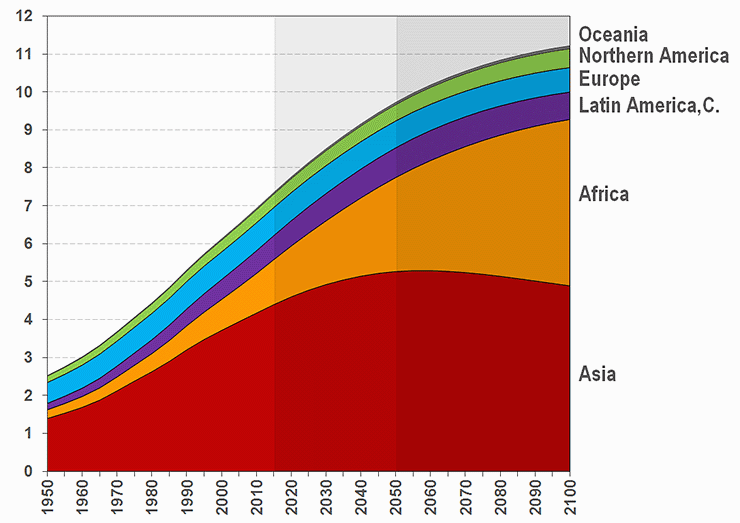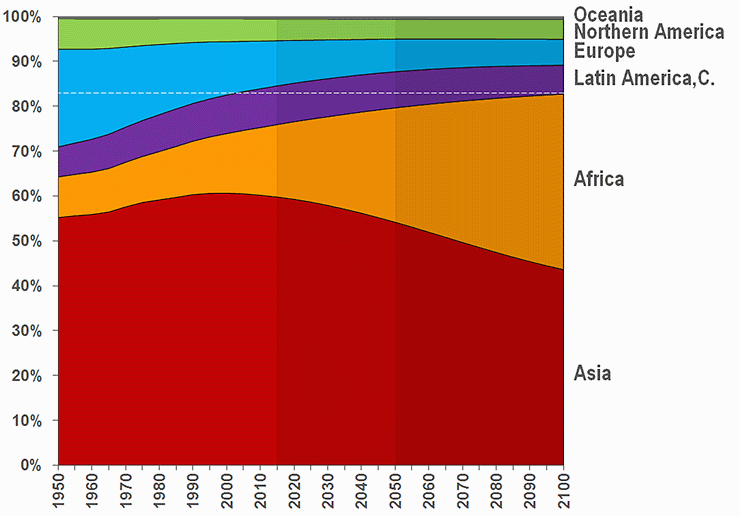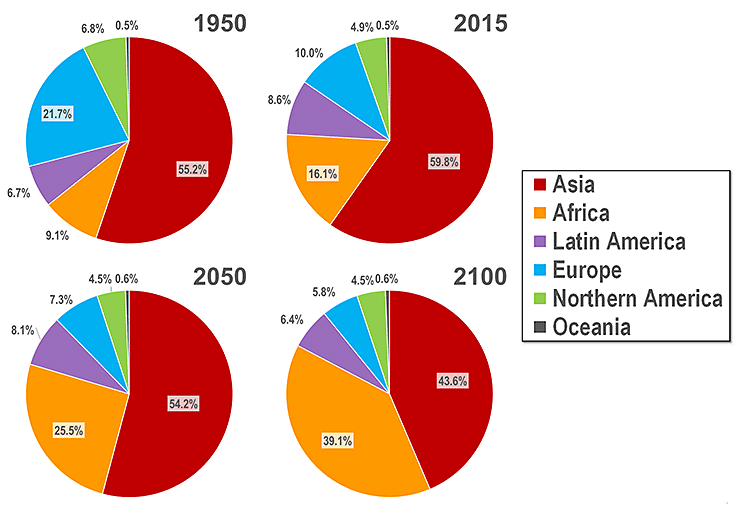World population by major regions, 1950-2100
Source: United Nations, WPP2015
World population growth during the 150-year period between 1950 and 2100 was, and will be, almost entirely concentrated in Africa and Asia. Together, Africa and Asia had a population of just 1.6 billion in 1950. Today, the population of Africa and Asia combined is almost 5.6 billion people, and by 2050 it will be more than 7,7 billion. By the end of the century Africa and Asia together could have a population of 9.3 billion people.
Percentage of world population by major regions, 1950-2100
Source: United Nations, WPP2015
Africa and Asia have therefore significantly increased their share of the world population from 64% in 1950 to 76% today. Over the next 35 years Africa and Asia will increase their share of the world population to almost 80% - and by the end of the 21st century 83% of all people on earth may be Asian or African.
Literature:
Gerland P., Raftery A.E., Ševčíková H., Li N., Gu D., Spoorenberg T., Alkema L., Fosdick B.K., Chunn J.L., Lalic N., Bay G., Buettner T., Heilig G.K. and Wilmoth J. (2014). World Population Stabilization Unlikely This Century. Science 346:234-237.
Raftery A.E., Li N., Ševčíková H., Gerland P., and Heilig G.K. (2012): Bayesian probabilistic population projections for all countries. National Academy of Sciences, PNAS, August 28, 2012, vol. 109, no. 35, 13915–13921
Alkema L, Raftery A.E., Gerland P., Clark S.J., Pelletier F., Buettner T. , Heilig G.K. (2011): Probabilistic Projections of the Total Fertility Rate for All Countries. Demography, vol. 48, 815-839
Share of world population by major regions
Source: United Nations, PPP2015
These four figures illustrate the epochal shift in the population of the world between the middle of the twentieth and the end of the twenty-first century. This shift is characterized primarily by the decline in the share of European populations and the increase in the share of people living in Africa.
Asia’s share of the world population has increased from 55% in 1950 to almost 60% today. But it will shrink again down to only 44% by 2100.
Africa‘s share of the world population will more than quadruple between 1950 and 2100 - from 9% to 39%.
Europe‘s share of the world population was about 22% in 1950. It is now down to only 10% and it will further decline to less than 6%.
Northern America‘s share of the world population will change very little and fluctuate between 5% and 7%.
Latin America‘s share of the global population will also change little and fluctuate between 6.7% and 8.6%.
These changes have fundamental consequences for the distribution of people by racial and ethnic groups; for the number of people who speak a particular language; or for the future of the world's religions. For instance, Muslims are, by far, the fastest growing population. According to a recent study by the Pew Research Center Muslims will nearly equal the number of Christians by 2050.
Literature:
Pew Research Center (2015) The Future of World Religions: Population Growth Projections, 2010-2050. Why Muslims Are Rising Fastest and the Unaffiliated Are Shrinking as a Share of the World’s Population.



